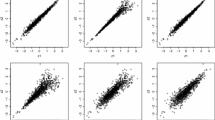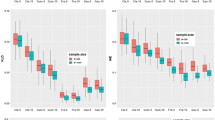Abstract
We propose exploratory, easily implemented methods for diagnosing the appropriateness of an underlying copula model for bivariate failure time data, allowing censoring in either or both failure times. It is found that the proposed approach effectively distinguishes gamma from positive stable copula models when the sample is moderately large or the association is strong. Data from the Women’s Health and Aging Study (WHAS, Guralnik et al., The Womens’s Health and Aging Study: Health and Social Characterisitics of Older Women with Disability. National Institute on Aging: Bethesda, Mayland, 1995) are analyzed to demonstrate the proposed diagnostic methodology. The positive stable model gives a better overall fit to these data than the gamma frailty model, but it tends to underestimate association at the later time points. The finding is consistent with recent theory differentiating ‘catastrophic’ from ‘progressive’ disability onset in older adults. The proposed methods supply an interpretable quantity for copula diagnosis. We hope that they will usefully inform practitioners as to the reasonableness of their modeling choices.
Similar content being viewed by others
References
K.J. Bandeen-Roche K.Y. Liang (2002) ArticleTitle“Modelling multivariate failure time associations in the presence of a competing risk,” Biometrika. 89 299–314
B.W. Brown M. Hollander R.M. Korwar (1974) “Nonparametric tests of independence for censored data, with application to heart transplant studies” F. Proschan R. J. Serfling (Eds) in Reliability and Biometry: Statistical Analysis of Lifelength SIAM Philadelphia 327–353
D.G. Clayton (1978) ArticleTitle“A model for association in bivariate life-tables and its application in epidemiological studies of familiar tendency in chronic disease incidence,” Biometrika vol. 65 141–151
D.M. Dabrowska (1988) ArticleTitle“Kaplan–Meier Estimate on the Plane,” The Annals of Statistics. 16 1475–1489
L. Ferrucci J.M. Guralnik E. Simonsick M.E. Salive C. Corti J.R. Langlois (1996) ArticleTitle“Progressive versus catastrophic disability: a longitudinal view of the disablement process,” Journal of Gerontology. Series A, Biological Sciences & Medical Sciences. 51 IssueID3 123–130
L.P. Fried W.H. Ettinger B. Hermanson et al. (1994) ArticleTitle“Physical disability in older adults: a physiologic approach,” Journal of Clinical Epidemiology. 47 747–760
S. Geman C.-R. Hwang (1982) ArticleTitle“ Nonparametric maximum likelihood estimation by the method of sieves,” Annals of Statistics. 10 IssueID2 401–411
C. Genest R.J. MacKay (1986) ArticleTitle“The joy of copulas: bivariate distributions with given marginals,” The American Statistician. 40 280–283
C. Genest L.P. Rivest (1993) ArticleTitle“Statistical inference procedures for bivariatearchimedan copulas,” Journal of the American statistical Association. 88 IssueID432 1034–1043
D.V. Glidden (1999) ArticleTitle“Checking the adequacy of the gamma frailty model for multivariate failure times,” Biometrika. 86 IssueID2 381–393
G. Gong F.J. Samaniego (1981) ArticleTitle“Pseudo maximum likelihood estimation: theory and applications,” The Annals of Statistics. 9 IssueID4 861–869
J.M. Guralnik L.P. Fried E.M. Simonsick J. Kasper M.E. Lafferty (Eds) (1995) The Women’s Health and Aging Study: Health and Social Characteristics of Older Women with Disability National Institute on Aging Bethesda, Maryland
P. Hall B.U. Park B.A. Turlach (1998) ArticleTitle“A note on design transformation and binning in nonparametric curve estimation,” Biometrika. 85 469–476
P. Hougaard (1986a) ArticleTitle“Survival models for heterogeneous population derived from stable distributions,” Biometrika. 73 387–396
P. Hougaard (1986b) ArticleTitle“A class of multivariate failure time distribution,” Biometrika 73 671–673
W.J. Huster R Brookmeyer S.G. Self (1989) ArticleTitle“Modelling paired survival data with covariates,” Biometrics. 45 145–156
E.L. Kaplan P. Meier (1958) ArticleTitle“Nonparametric estimation from incomplete observations,” Journal of the American Statistical Association. 53 457–481
M.G. Kendall (1938) ArticleTitle“A new measure of rank correlation,” Biometrika. 30 81–93
K.-Y. Liang (1991) ArticleTitle“Estimating effects of probands” characteristics on familial risk: I Adjustment for censoring and correlated ages at onset Genetic Epidemiology. 8 329–338
K.-Y. Liang S.G. Self K.J. Bandeen-Roche S.L. Zeger (1995) ArticleTitle“Some recent developments for regression analysis of multivariate failure time data,” Lifetime Data Analysis. 1 403–415
E.T. Lonergan J.R. Krevans (1991) ArticleTitle“A national agenda for research on aging,” New England Journal of Medicine. 1 IssueID324 1825–1828
A.K. Manatunga D. Oakes (1996) ArticleTitle“A measure of association for bivariate frailty distributions,” Journal of Multivariate Analysis. 56 60–74
A.W. Marshall I. Olkin (1988) ArticleTitle“Families of multivariate distributions,” Journal of the American Statistical Association. 83 834–841
D. Oakes (1989) ArticleTitle“Bivariate survival models induced by frailties,” Journal of the American Statistical Association. 84 487–493
S.M. Pizer (1975) “Numerical Computing and Mathematical Analysis,” Science Research Associates, Inc. Chicago
R.L. Prentice J.D. Kalbfleisch A.V. Peterson SuffixJr. N. Flournoy V.T. Farewell N.E. Breslow (1978) ArticleTitle“The analysis of failure times in the presence of competing risk,” Biometrics. 34 541–554
C.H. Reinsch (1967) ArticleTitle“Smoothing by spline functions,” Numerische Mathematik. 10 177–183
Schweizer B., Sklar A. (1983). Probabilistic Metric Spaces, New York: North-Holland, 1983.
J.H. Shih T.A. Louis (1995) ArticleTitle“ Inference on the association parameter in copula models for bivariate survival data,” Biometrics. 51 1384–1399
J.H. Shih T.A. Louis (1995) ArticleTitle“Assessing gamma frailty models for clustered failure time data,” Lifetime Data Analysis. 1 205–220
J.H. Shih (1998) ArticleTitle“A goodness-of-fit test for association in a bivariate survival model,” Biometrika. 85 189–200
B. Viswanathan A.K. Manatunga (2001) ArticleTitle“Diagnostic plots for assessing the grailty distribution in multivariate survival data,” Lifetime Data Analysis. 7 143–155
M.P. Wand (1997) ArticleTitle“Data-based choice of histogram bin width,” The American Statistician. 51 59–64
W. Wang M.T. Wells (2000a) ArticleTitle“Model selection and semi-parametric inference for bivariate censored data,” Journal of the American Statistical Association. 95 62–72
Author information
Authors and Affiliations
Corresponding author
Rights and permissions
About this article
Cite this article
chen, Mc., Bandeen-Roche, K. A Diagnostic for Association in Bivariate Survival Models. Lifetime Data Anal 11, 245–264 (2005). https://doi.org/10.1007/s10985-004-0386-8
Received:
Revised:
Accepted:
Issue Date:
DOI: https://doi.org/10.1007/s10985-004-0386-8




